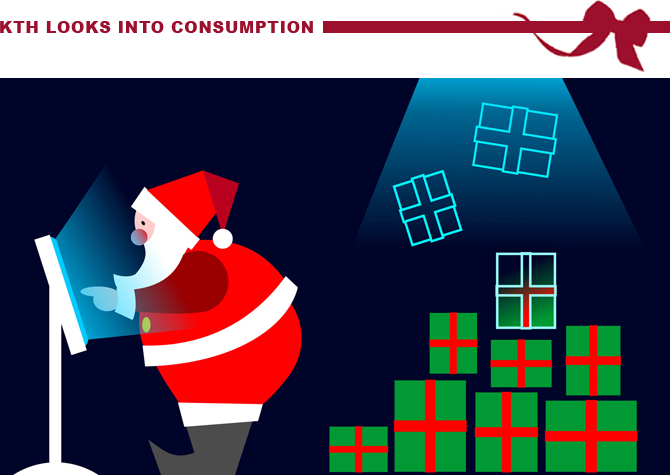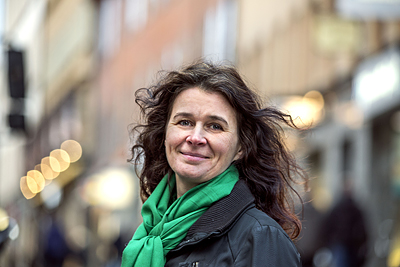
Online shopping, at what cost?
We save time and money by shopping online. But what about the environmental impact? Is it better or worse for the environment that goods and services are consumed via the Internet? Two KTH researchers explain that the answer is not that straightforward.
As new technologies, products and services are developed, Åsa Svenfelt and Miriam Börjesson Rivera want to shed light on undocumented ways in which they affect the environment.
Environmental impact assessments are one way the IT and ICT industries try to predict the environmental impact of products and services; but the two researchers at KTH’s Centre for Sustainable Communications (CESC) say that these assessments need to go further.
Svenfelt and Börjesson Rivera work with the CESC’s ongoing research project, Methods for Sustainability Assessments of ICT, which aims to make it possible for environmental impact assessments to not only take stock of the direct effects, but the indirect ones, too.
It’s not news that the holiday shopping season accounts for most of Sweden’s overall retail business. But what is changing is that an ever-increasing number of gifts are purchased on the internet. More than one-third of the presents people have purchased this year are online purchases, according to a survey by Postnord.
The CESC study involves developing methods for evaluating IT solutions from a sustainability standpoint. In other words, how can such solutions contribute to sustainable development?
“We conduct interviews where we ask people about their consumption habits,” explains Börjesson Rivera. “Do you shop online? Do you look in a brick-and-mortar store before ordering online? Or do you research online before shopping in a regular store? What kind of consumption do people do with digital services? Do they stream their music or buy records? How do you watch film and television?”

Börjesson Rivera is a social anthropologist who looks at the phenomenon of consumption from a sociological perspective. A key concept in this research is social practices. It's about what people do in their everyday lives and how they do it.
“You can see everyday consumption as a social practice,” she says. “And a social practice includes different elements, technology, i.e. the things needed to make social practice, the ability to use technology and the specific social practice meaning. In the case of consumption, it is about what it means to consume and what are the kind of thoughts and values associated with it? Thoughts and values one has in common with others who live in the same country,” Börjesson Rivera says.
Börjesson and Svenfelt will take the material they get in these interviews, and try to place it in possible scenarios for the future, in order to see which second-order effects on the environment (indirect environmental effects) are associated with the different ways people consume.
The idea is that these indirect effects will eventually be taken into account in the evaluation of IT products and IT services environment. Today, only the direct environmental effects, such as waste or how much energy a product draws, are usually taken into account in such evaluations.
Taking aim at these indirect effects is considered a more innovative approach, which provides more comprehensive assessments when a new technology, product or service is developed.
“Second-order effects on the environment are like ripples in the water. They spread in the system, often because people use things in a certain way that you might not think about when designing a product or service,” says Svenfelt, who analyses possible future social practices and how they can be worked into the scenarios.
IT and ICT are generally regarded as promising areas for improved sustainability. Online meetings and shopping are thought be potential energy savers. “But then one thinks only of these direct effects and not the second order effects on the environment,” Svenfelt says. “It may seem like a good idea to introduce a service to save energy. But second-order effects may show that the way the service is used might actually counteract the whole purpose.”

Take ordering groceries via the internet, for example, she says. It is argued that this reduces transport, because people are not driving around themselves. “But if you live in the inner city, online grocery orders lead to increased traffic because it adds to the number of distribution vehicles driving to people inside the city – people who might live only 100 metres to the nearest food store.
“In that case, perhaps it would have been better if you had not ordered food online, but gone and shopped at the store yourself.”
Speaking of trade and that the holidays are here, what do Svenfelt and Börjesson Rivera wish for Christmas?
“For myself, I have wished for gift cards for breakfast in bed from my children. But if I get a wish in a larger perspective, it is that we all reflect little more on what we buy each other as Christmas presents and why. In this way, we may be able to buy goods and services with less environmental impact and sometimes perhaps avoid consumption altogether,” Svenfelt says.
“I wish for a nice time off with my family and that everyone stays healthy,” Börjesson Rivera says.
The project, Methods for Sustainability Assessments of ICT, continues until June 2015th
Håkan Soold

